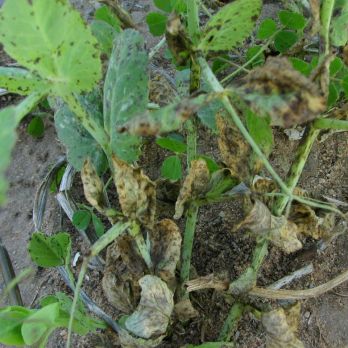Crop Watch 28 April 2023

Blackspot Manager forecast released
The Blackspot Manager disease forecast indicates a highly variable risk of blackspot disease in seedling field pea crops sown late April to early May across South Australia in 2023.
Several locations are forecast to be at high risk of blackspot disease, while in other districts the risk is considered low or medium. View the Field pea blackspot management guide for South Australia to learn more about the situation in your area.
The risk identified in Blackspot Manager is associated with the number of spores released from last year's stubble. Actual disease severity will also depend on rainfall patterns during crop establishment as moisture is necessary for the spores to germinate and infect the plants.
Spores released with rainfall in late autumn and winter, when new crops are emerging and establishing, will lead to a high risk of blackspot establishing in crops. Numerous rainfall events will increase disease severity, but if there are few rainfall events then very little disease will eventuate irrespective of spore numbers.
What you can do to reduce crop disease risk
- Sow this year's crop at least 500 metres from field pea stubble.
- If downwind from the stubble, increase this distance to 1 kilometre if possible since the spores are windblown.
- Delay sowing by 2 to 3 weeks past opening rains in medium to high rainfall districts where this is unlikely to compromise yield.
- The spore numbers in the air will reduce over the 2 to 3 week window and reduce the blackspot risk.
- Note that delayed sowing is not an option in low rainfall, short season districts as associated yield losses will be greater than losses caused by blackspot disease.
- Consider fungicide strategies as an option in crops with a yield potential of at least 1.5 tonnes a hectare.
- A seed dressing with both thiram and thiabendazole fungicide (e.g. P Pickel T) will reduce infection on seedling crops, and foliar fungicide sprays will reduce the spread of the disease.
- Sprays can be applied between 4 to 8 nodes; apply at 4 nodes if disease is present but delay towards 8 nodes if disease is not evident.
- A second spray is needed at early flowering to reduce spread of the disease in spring.
- For maximum effect, spray ahead of a rain event, since spores are spread during rain.
- Post-rain spraying is generally ineffective.
- Several products are registered for control of blackspot of field peas. Note label restrictions for chlorothalonil with respect to grazing stock.
Stay up to date with the latest disease-related issues and solutions for broadacre crops during the growing season.


